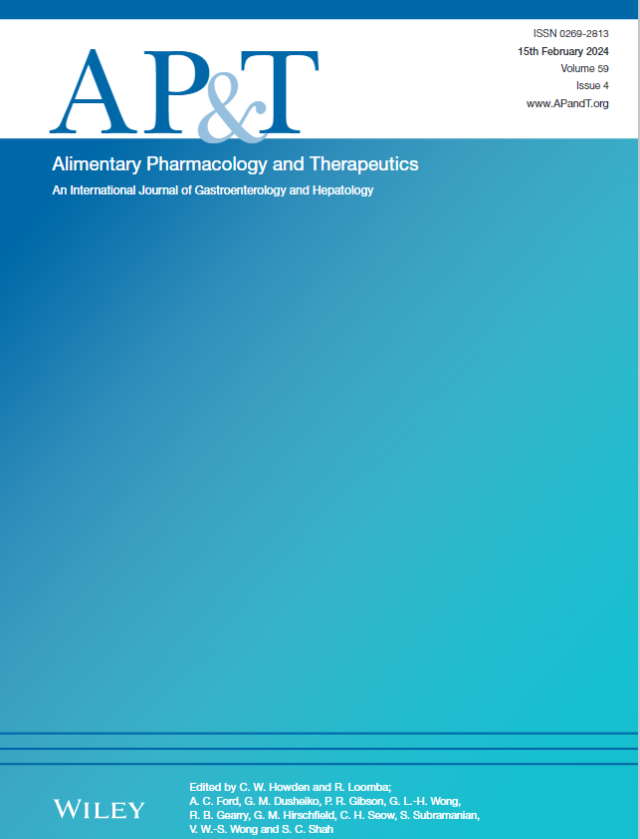自身免疫性肝炎患者并发糖尿病:发病频率、危险因素及对预后的影响
IF 6.6
1区 医学
Q1 GASTROENTEROLOGY & HEPATOLOGY
引用次数: 0
摘要
自身免疫性肝炎(AIH)的治疗包括皮质类固醇,这与糖尿病(DM)的发展有关。AIH患者中新发糖尿病的发生率各不相同,易感因素和预后影响也没有得到充分的描述。目的探讨糖尿病在AIH中的发病频率、易感因素及其与疾病进展和死亡率的关系。方法回顾性/前瞻性单中心研究494例1987-2023年AIH患者,466例接受皮质类固醇治疗(454例强的松龙,12例布地奈德),随访(中位(范围)9(0-36)年)。结果47例患者(10%)在AIH诊断时已患有糖尿病。另外59例(13%)出现新发糖尿病。在接受强的松龙治疗的患者中,1年后新发糖尿病的发生率为8%±1%,10年后为14%±2%(比预期的人群发生率高14倍和3倍),并且与年龄较大、非高加索人种、较高的初始强的松龙剂量、较高的诊断时BMI和随访2年后体重增加独立相关。新发糖尿病通常在停用强的松龙后仍持续存在。新发糖尿病和任何时间的糖尿病与全因死亡/移植率独立相关,同时也与先前确定的危险因素(年龄较大、肝硬化、诊断时ALT较低和早期ALT正常化失败)相关。新发糖尿病和任何时间的糖尿病也与肝硬化发展独立相关。在单因素分析中,新发糖尿病和任何时间的糖尿病与肝脏相关死亡/移植有相似的相关性,但在多因素分析中没有显著的相关性。结论:13%的AIH患者发生新发糖尿病,与年龄较大、非白种人、较高的泼尼松龙剂量、诊断时较高的BMI和体重增加有关;并且是全因死亡/移植和肝硬化发展的独立预测因子,强调AIH患者需要尽量减少类固醇负担。本文章由计算机程序翻译,如有差异,请以英文原文为准。
Diabetes Mellitus in Patients With Autoimmune Hepatitis: Frequency, Risk Factors and Effect on Outcome
BackgroundTreatment for autoimmune hepatitis (AIH) includes corticosteroids, which are associated with the development of diabetes mellitus (DM). Reported new‐onset DM rates in patients with AIH have varied, and predisposing factors and prognostic implications are inadequately characterised.AimTo identify the frequency and predisposing factors for DM in AIH and its association with disease progression and mortality.MethodsRetrospective/prospective single‐centre study of 494 patients with AIH presenting 1987–2023, 466 receiving corticosteroids (454 prednisolone, 12 budesonide) and followed for (median (range) 9 (0–36) years).ResultsForty‐seven patients (10%) already had DM at AIH diagnosis. New‐onset DM subsequently developed in another 59 (13%). In those receiving prednisolone, new‐onset DM incidence was 8% ± 1% after 1 year and 14% ± 2% after 10 years (14‐ and 3‐fold higher than expected population rate), and was independently associated with older age, non‐Caucasian ethnicity, higher initial prednisolone dose, higher BMI at diagnosis and more weight gain after 2 years of follow‐up. New‐onset DM usually persisted despite stopping prednisolone.New‐onset DM and DM at any time were independently associated with all‐cause death/transplantation rate, along with previously established risk factors (older age, cirrhosis, lower ALT at diagnosis and failure of early ALT normalisation). New‐onset DM and DM at any time were also independently associated with cirrhosis development. Similar associations of new‐onset DM and DM at any time with liver‐related death/transplantation were significant on univariate but not multivariate analysis.ConclusionNew‐onset DM occurred in 13% of patients with AIH, was related to older age, non‐Caucasian ethnicity, higher prednisolone dose, higher BMI at diagnosis and weight gain; and was an independent predictor of all‐cause death/transplantation and of cirrhosis development, underlining the need to minimise steroid burden in AIH.
求助全文
通过发布文献求助,成功后即可免费获取论文全文。
去求助
来源期刊
CiteScore
15.60
自引率
7.90%
发文量
527
审稿时长
3-6 weeks
期刊介绍:
Alimentary Pharmacology & Therapeutics is a global pharmacology journal focused on the impact of drugs on the human gastrointestinal and hepato-biliary systems. It covers a diverse range of topics, often with immediate clinical relevance to its readership.

 求助内容:
求助内容: 应助结果提醒方式:
应助结果提醒方式:


